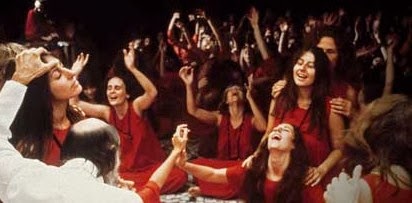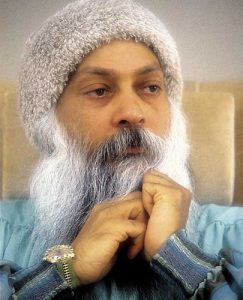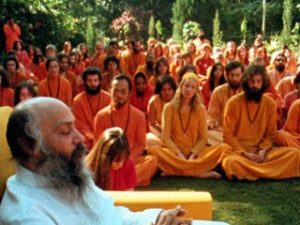Bhagwan Shree Rajneesh
Bhagwan Shree Rajneesh (1931-90) started life as Chandra Mohan Jain, gaining the nickname of Rajneesh. Born in Central India to Jain parents, he became a freethinker. He acquired an M.A. degree in philosophy at Saugor University in 1957. Meanwhile, his academic life was attended by what he later described as a nervous breakdown, and paradoxically, by a purported “enlightenment” dating to 1953.
Subsequently Rajneesh became a professor of philosophy, lecturing for nearly a decade at Raipur and Jabalpur. In 1966, Jabalpur University insisted that he resign from his academic position after a controversial lecture tour; he was advocating an open acceptance of sexual activity against conventions. Rajneesh also became infamous as a critic of Mahatma Gandhi. Three years later, on the centenary of Gandhi’s birth, he caused an outrage as a consequence of his theory that Gandhi’s sexual abstinence was a form of perversion.
Rajneesh had already commenced his career as a spiritual teacher or acharya, attracting the attention of wealthy, upper class Indians. He lectured at “meditation camps” and other venues. He gave his first address to a Western audience in 1969. In 1970, he settled at Bombay (Mumbai), where he gave regular public lectures to large mixed audiences. A system of ticket fees was in operation. Rajneesh liked to engage in pronounced criticism of orthodox religion, but not merely ritualism. Conventions were wrong, he said; all repression must go. He became known as the “sex guru.”
During the Bombay phase, his programme was designed to “exhaust” clients with five daily “dynamic meditations” lasting for an hour at a time. The novelty on offer was not contemplative, instead comprising energetic body movements, hyperventilation (breathwork), and cathartic abandonment. Nudity was also encouraged.
Rajneesh described his speciality of “dynamic meditation” in terms of “going totally mad.” Other exercises were also favoured at the Poona ashram he launched in 1974. By the 1980s, these exercises included the “No Mind” meditation. This extremism “involved ten minutes nightly in forcibly speaking gibberish while ‘going completely crazy’ before a 20-minute witnessing period” (Conway, Rajneesh biography).
Rajneesh was often mistakenly considered by Westerners to represent Hinduism. He was not a Hindu, nor a traditional Jain, but instead an entrepreneur favouring Reichian therapy and related vogues of the Western commercial scene. Reichian theory (of Wilhelm Reich) has been identified as underlying many of the idiosyncratic therapies promoted by Rajneesh during the 1970s at his Poona ashram (Carter 1990:41, 84, 112-14). Rajneesh insisted that repression of sexual energy is the cause of most individual problems. His own career served to disprove this Reichian fallacy.
His new age extremism may be discerned in his antipathy for Mahatma Gandhi, whom he placed on the level of Adolf Hitler in a relativistic scenario of torture. Rajneesh described Gandhi as a self-torturer, and Hitler as a torturer of others. He also stated: “Gandhi had the Jaina [ascetic] characteristic very much developed in him.” Hitler was equated with Islam. Both were described by Rajneesh as great saints. These idiosyncratic musings were included in a book on Zen published in 1980, part of the Rajneesh corpus which confused many thousands of readers (those books were not writings, but comprised edited discourses).
Rajneesh did not wish to emulate the fasting privations of Gandhi, who lived in rustic simplicity. Instead, the “sex guru” collected jewellery and Rolls Royce automobiles, eager not to deny himself any superfluous commodity. He was not a celibate like the traditional Jain and Hindu ascetics; reports of his behaviour attest his disposition to free love. “Close early Western disciples… and others heard from young women of having their breasts groped and vaginas fondled by the Bhagwan, before Rajneesh graduated to having full intercourse with some of them during ‘private darshans’ ” (Conway, Rajneesh biography). The young Indian woman Kranti lost out in these activities to the more desirable British partner Christine Wolff, alias Ma Yoga Vivek. According to ex-devotee Christopher Calder, Rajneesh “had sex with hundreds of young women half his age,” meaning his meditation converts.
In 1971, Rajneesh assumed the elevated Hindu title of Bhagwan (Lord). The preceding year, he had commenced to initiate admirers as “sannyasins,” in the context of his Neo-Sannyas International Movement. The word sannyas means renunciation; Rajneesh inverted the traditional meaning. Rajneeshi sannyasins have been described as anti-renunciates. These people acquired new Indian names, bead necklaces, and ochre (later red) robes. Indians were involved, but increasingly, Rajneesh catered for Westerners. During the 1970s, many thousands of Americans, Germans, and other foreigners became “sannyasin” recruits for neo-Reichian therapy, Dynamic Meditation, and free love. Hindus generally disowned the Rajneesh “neo-sannyasin” activity as a promiscuous aberration.
Rajneesh and his neo-sannyasins
One of the very earliest Western neo-sannyasins was Christopher Calder, a British convert who first met Rajneesh in 1970. Given the exotic new name of Swami Krishna Christ, Calder became disillusioned after several years. Much later, he contributed two online articles that are radically informative and very critical of his former guru.
Calder poses the question: “What did Rajneesh want and get?” He adds: “The answer is millions of dollars, absolute power, a harem of women, and a daily supply of drugs.” Rajneesh is reported to have experienced a brief experimentation with LSD. In the long term, he was “inhaling enough nitrous oxide to inflate a dirigible” (Calder, Ridiculous Teachings).
The confused Western reception, of Rajneesh emphases, can be sampled in such works as Encyclopaedia Britannica, which states: “Rajneesh became well known for his progressive approach to sexuality, which contrasted with the renunciation of sex advocated by many other Indian teachers” (accessed December 2013).
This comment refers to the 1970s Poona (Pune) ashram established by Rajneesh, where “dynamic meditation” blended easily with alternative therapy of the Western “new age.” The Reichian appetite of Rajneesh encouraged pseudo-therapeutic approaches found in the Esalen and related commercial directories. The Encyclopaedia Britannica misleadingly refers to this episode as “a diversified program of New Age healing” (accessed December 2013).
In 1975, Rajneesh launched an extensive therapy programme at his new Poona ashram, in collaboration with Western alternative therapists. This was a big business project. The Western entrepreneurs (associated with the Human Potential Movement) desired a situation where they were free to experiment with forms of lucrative therapy considered dangerous by medical authorities in the West. Rajneesh had by now incorporated production industries in his overall business activity. Intellectuality was zero-rated as an encumbrance.
Feminists of that period were susceptible recruits via the “merchandising of orgasm,” a phrase employed in some sources to describe the nature of events. Rape victims in therapy sessions were easily overlooked. Four letter words were much in vogue. One type of neo-Reichian therapy, favoured by Rajneesh, involved an incitement to this form of crude diction, “accompanied by nudity and violent expression” (Shepherd 2004:60). Of course, Rajneesh claimed to be an exemplar of non-violence. His rivals like Mahatma Gandhi were supposedly savages in their self-restraint.
Even Richard Price, the gullible Esalen co-founder, found that Rajneesh “therapy” was extremely dangerous. “He discovered that the Rajneesh version of the encounter group encouraged clients to be very violent, to the extent that old women were hit in the face by young men. Price himself is said to have suffered a broken arm while being locked up for an hour in a room with eight people armed with wooden weapons…. Price reported seeing eighteen fights in the therapy sessions within only two days, and that was before he stopped counting them” (Shepherd 2004:60-1).

Rajneesh creating emotional arousal at the Poona ashram
Rajneesh taught that sexuality and aggression were primary emotions to be released in his workshops. The recruits became addicted to those emotions and other forms of arousal. The guru encouraged swooning and sobbing amongst his female devotees. “The Rajneesh cult advertised the ‘bliss’ said to be found in their therapies and dynamic meditations; yet they frequently administered pills, injections, and tranquillisers to those who became unmanageable” (Shepherd 2004:61). The local hospital in Poona was accustomed to Rajneeshi victims.
Despite all the “therapy,” Rajneesh himself developed allergies and suffered asthma attacks. So-called Dynamic Meditation could not prevent the need for medical attention. He suffered from diabetes, eczema, and severe back pain caused by a disc problem. Calder reports that Rajneesh was “constantly sick and frail from the time I first met him in 1970.” The guru’s health had already been impaired during the 1960s; the cause is here specified in terms of Chronic Fatigue Syndrome (Calder, Lost Truth).
The Poona ashram of Rajneesh was an insult to traditional Hindu ideals of discipline and self-control. A favoured activity was group sex. The prevalent licentious habits caused sexually transmitted diseases. Over eighty percent of the commune residents are reported to have contracted this form of disease by the 1980s.
A stimulus to disease came in the form of lewd jokes frequently expressed by Rajneesh. Rapist episodes were considered very funny. The audience were expected to laugh. Many jokes of this kind appeared in the discourse books of Rajneesh, which supposedly proved his knowledge and ability in traditions like Hinduism, Sufism, Zen, and Taoism. The reaction of critics was to deem his sordid mentality an index to debauchery and indulgence.
The excessive emphases upon non-restraint passed to the children of commune members. Sexual intercourse amongst children was reported. There were instances like that of a six year old girl who offered her abilities in oral sex to adult males (Franklin 1992:108). The account of neo-sannyasin Jane Stork reports that her children were sexually abused while she lived at the commune (she became a resident from 1978 until 1985; see Stork, Breaking the Spell, 2009).
This was an ongoing situation in which adult males could copulate with girls only ten years old. The permissive Rajneesh often declared that the family was a repressive factor, and accordingly had to go. His tendency to break up families assisted the commune focus upon himself as the dominant priority.
Rajneesh invented [at Poona] a programme of ‘dehypnotherapy’ intended to free his followers of all prior constraints of their native culture, a process which involved acute exposure to his relativistic philosophy which endorsed opposites as being simultaneously true. (Shepherd 2004:61; Carter 1990)
One of the influences upon Rajneesh was the philosopher Friedrich Nietzsche, whose fictional work Thus Spake Zarathustra was popular amongst his Western followers. The Nietzschean idea of the “superman,” ascending by his selfish will to power, was surely demonstrated by Rajneesh.
Some of his extant discourses exhibit a preoccupation with the philosophy of Nietzsche and the sexual liberation expressed by D. H. Lawrence, with a fashionable assimilation of Gurdjieff and humanistic psychology also in evidence. This hybrid fare reflected his opportunistic policy of tailoring teachings to market demands. (Shepherd 2004:62; Carter 1990)
A German camera crew filmed the violence and nudity of the late 1970s Rajneesh encounter groups. The footage was preserved in the documentary film Ashram (1980). This movie confirmed the reports of “therapy” excess. In 1979, as a consequence of Indian disapproval, Rajneesh curtailed some of the excesses, including fighting.
That cosmetic gesture did not affect the ashram income. Circa 1980, the Poona ashram was host to about fifty-five therapy groups, each with about forty participants who paid at least a hundred dollars per head. There was a greater influx of visitors at the time of major events. About 30,000 visitors per year were involved, plus a few thousand residents. Rajneesh sometimes used the word Tantra to describe all this activity. The subject of Tantra does not accurately come under the umbrella of therapy.
The guru became well known for his advocacy of Tantra. Ex-devotee Calder says that, in a lecture, Rajneesh defended the “Tantric practice of parents having sex with their own children.” More to the point, the guru “used the myths of Tantra to rationalise all of his dishonest and illegal behaviour, as well as his own exorbitant drug use” (Calder, Ridiculous Teachings). Rajneesh used the well known phrase “lefthanded Tantra,” which can elsewhere signify deviation; today, the distinction is lost in the craze for sex tantra. At Poona, “one of the groups Rajneesh sold to students was the ‘Tantra’ group, which was basically just male and female disciples having sex with each other” (Calder, Lost Truth).
The subsequent “tantric workshop” advocate, Margot Anand, claimed an affiliation with Rajneesh; she is said to have visited the Poona ashram and there learned/taught Tantra, before moving on to America. The popular sex tantra became evident in her books, including Sexual Ecstasy: The Art of Orgasm (2000). This trend has received some criticism, including an extension at the Findhorn Foundation.
A large number of female Rajneeshis are reported to have become prostitutes, influenced by the prevalent commune license. These neo-sannyasins opted for a role as strippers in places like Soho and San Francisco (Strelley 1987:140, cited by Conway, Rajneesh biography). This activity was evidently regarded by the guru as a source of funding for neo-Tantra.
Many of the “sannyasins” were drug-users. Several of them were arrested while attempting to smuggle drugs into Europe (McCormack 2010:11). MDMA and cannabis were favoured commodities. Rajneesh is reported to have expressed approval of his “sannyasins” financing their Indian sojourns via drug dealing and prostitution. All the time, he benefited from the donations of his followers. The ongoing traffic in drugs was attended by overpowering justifications. A Rajneeshi, arrested for drug smuggling, made the statement:
The disciples of God [Rajneesh] cannot be made to submit to any of the laws established for ordinary human beings. To attain our goal, everything is permitted. (McCormack 2010, back cover)
Rajneesh secretly departed from Poona in June 1981, en route to America. Not being eligible for charity status, he was evading payment of income tax equivalent to four million dollars. One commentator describes how an informant divulged that a warrant for the guru’s arrest was imminent, on the basis of incitement to religious rioting (Milne 1986:182-3, 187ff.). The expansionist plans of Rajneesh in Poona, together with his controversial agenda, had aroused local resentment amongst Hindus. The pretext for his departure from Poona was a need for emergency medical treatment, a factor denied by close analysts.
A bibliography will be included in Part 2 of this article.
Kevin R. D. Shepherd
ENTRY no. 57
Copyright © 2013 Kevin R. D. Shepherd. All Rights Reserved.




